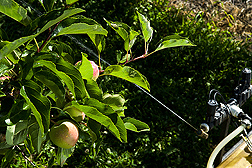This page has been archived and is being provided for reference purposes only. The page is no longer being updated, and therefore, links on the page may be invalid.
Read the magazine story to find out more. |
|
|
New Pheromone Sprayer Leads Amorous Moths Astray
By Jan SuszkiwSeptember 27, 2007
For decades, apple and pear growers have "adorned" their orchards with hundreds of plastic dispensers that emit a chemical sex attractant, or pheromone, to disrupt codling moth mating. Now, thanks to Agricultural Research Service (ARS) studies in Wapato, Wash., growers could soon be spraying the pheromone instead.
Growers customarily hang the pheromone dispensers from tree limbs by hand—often 200 to 400 of them per acre. It's a laborious, costly affair, notes Alan Knight, an entomologist with ARS' Yakima Agricultural Research Laboratory in Wapato.
Although spraying pheromone isn't a new idea, early attempts stumbled on technological hurdles. In 2003, Knight decided to give it a try based on a 1999 observation he had made while testing a fluorescent dye he had added to a sprayable, microencapsulated pheromone product developed by a Bend, Ore., company.
Using the dye and a black light to examine microcapsule densities on tree leaves, Knight determined the codling moth pheromone's delivery could be improved using ultra-low-volume (ULV) spraying. Besides cutting water use from 100 gallons to 1.25 gallons per acre, Knight's approach increased the microencapsulated pheromone's deposition rate by six- to 10-fold.
His trials in apple and pear orchards since 2003 show that ULV spraying four to six times a season disrupted codling moth mating as effectively as the hand-hung dispensers. Knight determined this from captured-moth counts and reductions in fruit damage. In 2005, he expanded the studies to include ULV spraying of the insecticide esfenvalerate, which curbed moth egg-laying by 95 percent.
If unchecked, hatchling moth larvae waste little time boring inside nearby fruit, ruining its marketability. Besides apples and pears, the pests also attack walnuts.
Knight is testing reduced-insecticide rates in combination with the pheromone. And to the sprayer itself, he's making adjustments that include adding an electronic "eye" to direct pulses of material into the center of a tree's canopy.
Read more about the research in the September 2007 issue of Agricultural Research magazine.
ARS is the U.S. Department of Agriculture's chief scientific research agency.

